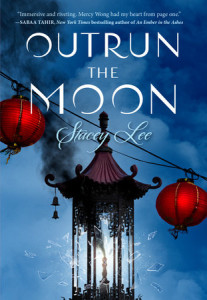Hurricanes. Five-hundred year floods. A tornado outbreak. A deadly heat wave. An earthquake. All these are natural disasters that can either tear communities apart or bring them together. While it seems like the hurricanes, tornadoes, and heat waves are getting more potent and the 500 year floods seem to be happening every five or ten years, earlier generations experienced terrible disasters with fewer resources to respond to them. One of the worst in U.S. history was the 1906 San Francisco earthquake and fire, which killed more than 3000 people and destroyed four-fifths of the city. As Stacey Lee shows in her gripping YA novel Outrun the Moon, this event brought a diverse but ethnically segregated city together as it tested the skills and leadership of residents young and old.
 Lee’s protagonist, 15-year-old Mercy Wong, stands out in her Chinese family and community for her “bossy cheeks,” the physical manifestation of her boundless ambition and independence. Mercy doesn’t want to spend her life working in her father’s laundry, nor does she want her sickly younger brother, Jack, anyway near the laundry. Having aged out of the Chinatown school, Mercy dreams of attending St. Clare’s Academy, and dragging Jack across town to meet with the vain wife of a board member shows that she will stop at nothing to get what she wants. She does get into the exclusive girls’ boarding school, but it’s a mixed blessing. The boy she’s had her eye on, Tom Gunn, son of the traditional Chinese doctor, thinks she doesn’t care enough about him, and he decamps for Seattle. Most of the white girls at the school – save for a friendly Texan and a working-class Italian girl who dreams of running her family’s restaurant – don’t accept her. She has to lie about who she is, telling them she’s an heiress from China, because St. Clare’s does not admit local Chinese girls.
Lee’s protagonist, 15-year-old Mercy Wong, stands out in her Chinese family and community for her “bossy cheeks,” the physical manifestation of her boundless ambition and independence. Mercy doesn’t want to spend her life working in her father’s laundry, nor does she want her sickly younger brother, Jack, anyway near the laundry. Having aged out of the Chinatown school, Mercy dreams of attending St. Clare’s Academy, and dragging Jack across town to meet with the vain wife of a board member shows that she will stop at nothing to get what she wants. She does get into the exclusive girls’ boarding school, but it’s a mixed blessing. The boy she’s had her eye on, Tom Gunn, son of the traditional Chinese doctor, thinks she doesn’t care enough about him, and he decamps for Seattle. Most of the white girls at the school – save for a friendly Texan and a working-class Italian girl who dreams of running her family’s restaurant – don’t accept her. She has to lie about who she is, telling them she’s an heiress from China, because St. Clare’s does not admit local Chinese girls.
Mercy is a very good liar – a source of much humor at the beginning of her time at the school – but her ruse is about to be exposed when the earthquake hits. Her problems with her classmates and the director give way to a struggle for survival. Despite the blows of personal tragedy, bossy-cheeked Mercy rises to the challenge, bringing former adversaries along with her.
Outrun the Moon shows how people of different backgrounds can come together in a crisis, through the efforts of unlikely or underappreciated leaders. Mercy, too, learns that she cannot pursue success for herself alone – wherever she is, she is part of a community and owes much to that community. Lee’s novel offers wisdom drawn both from Chinese traditions and beliefs and from the experience of a young person facing challenges she could never have imagined. Her vivid descriptions immerse readers in the dark alleyways of Chinatown and in the burned, broken city following the earthquake. Two brief historical notes explore what is known to be true, what is not known, and where Lee has altered the history in the service of the story. These are worth reading for their potential to spark discussion on the place of historical fiction and how the author weaves fact and fiction.
Coming tomorrow – an interview with Stacey Lee, author of both Outrun the Moon and Under a Painted Sky, which features a Chinese-American girl along the Oregon Train in 1848.
1 comment for “Does Disaster Bring Us Together? A Review of Outrun the Moon”